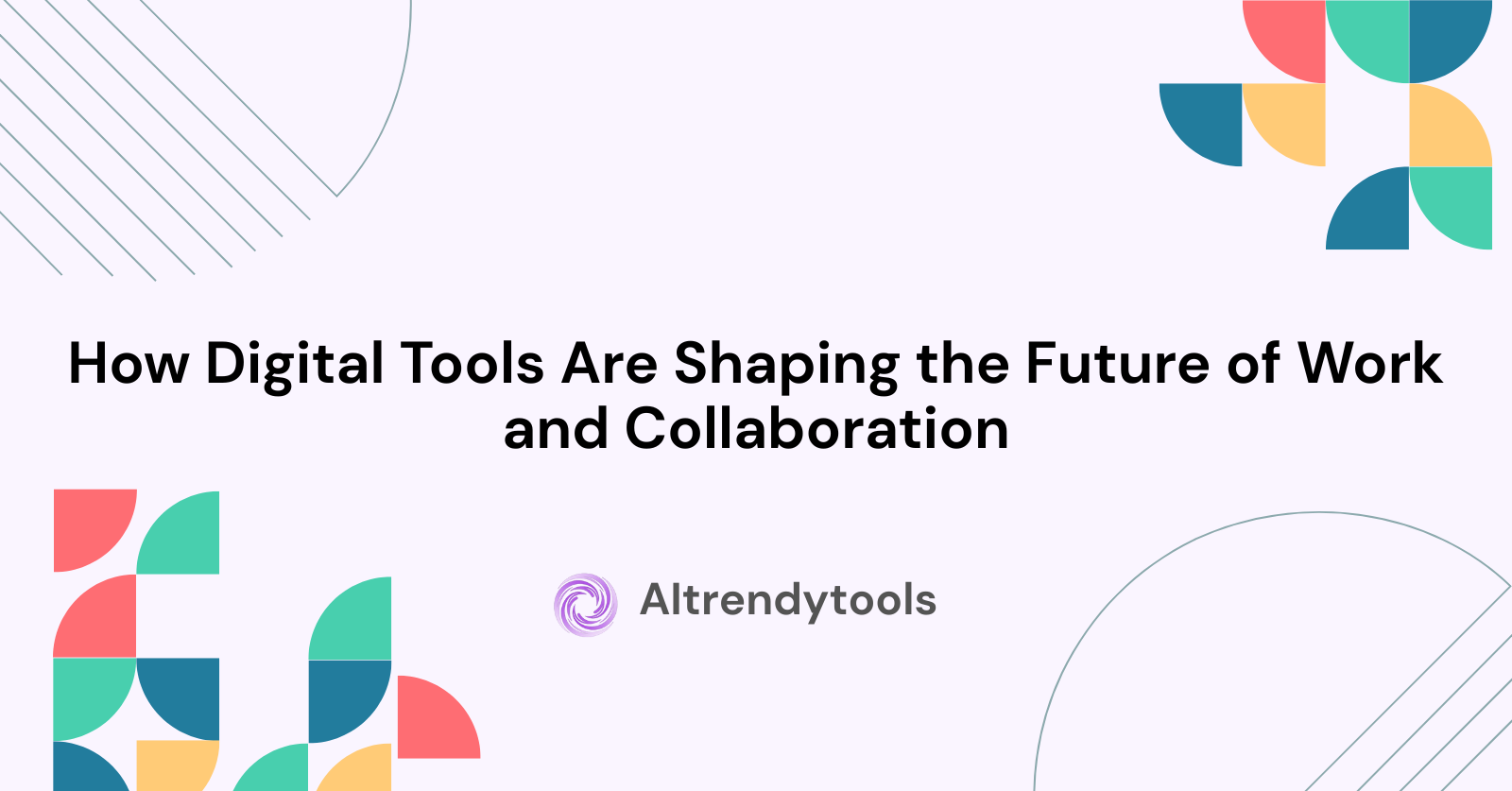🔥 AITrendytools: The Fastest-Growing AI Platform |
Write for usHow Digital Tools Are Shaping the Future of Work and Collaboration
Discover how digital tools are transforming collaboration, decision-making, and productivity in the modern workplace—remote, hybrid, or in-office. Ask ChatGPT
Jul 31, 2025
Think your team needs another tool to make their work easier? Think again. What they need is a smarter way to work. Less chaos, more clarity, and tools that support people, not just productivity.
The 9-to-5-in-an-office routine? It’s been replaced with Slack pings at 7 a.m., shared dashboards at midnight, and teams spread across time zones and calendars. And somewhere between your fifth Zoom of the day and a Google Doc with 16 anonymous animals, you’ve probably thought: Is this really better?
Good news! It can be. But only if we use the right tools in the right ways.
Let’s break down how digital tools are reshaping how remote teams collaborate, make decisions, and stay connected (without losing their minds in the process).
What’s Changed?
The biggest shift isn’t what we’re doing. It’s how we’re expected to do it, all at once, from anywhere, with fewer meetings and more results.
In the past, collaboration was tied to location. You had in-person brainstorms, shared office whiteboards, and “quick chats” by the coffee machine. Now? Everything is async, cloud-based, and documented, which is great until it's not.
The modern team’s reality:
- Projects move fast, sometimes too fast.
- Communication happens in bursts across multiple platforms.
- “Just checking in” feels like micromanaging, even when it’s not.
- We’re more connected than ever—and somehow still feel siloed.
A Closer Look at the Tools Teams Use
So what’s in the real-world tech stack of fast-moving SaaS teams?
- Design and product teams are shaping ideas with Figma and Miro, because sometimes you need to wireframe quickly, brainstorm visually, and maintain that creative flow without hopping between multiple platforms.
- Engineering teams spend their days inside GitHub, Jira, and Linear. Tools that support iterative development, issue tracking, and code collaboration without derailing the workflow.
- Marketing and content teams are juggling campaigns and copy in Notion, Trello, Grammarly, and Google Docs. Why? Because clarity, cooperation, and version control are non-negotiable when you’re publishing at scale.
- Ops and strategy folks? They’re building automations and managing team processes in Airtable, Asana, and ClickUp, getting cross-functional teams on the same page without forcing everyone into the same meeting.
What all these tools have in common is that they integrate seamlessly into how teams already work. They reduce the friction of context-switching, help you find what you need when you need it, and make collaboration less of a headache.
Making Work Visible (Without Micromanaging)
There’s a fine line between checking in and checking up on someone, and most of us have felt the sting of being on the wrong side of it. Whether you’re leading a team or part of one, the tension is familiar: leaders need visibility, but teams crave trust and autonomy.
When the right tools are in place, you don’t need to constantly ask, “Hey, where’s that thing?” or chase down updates in DMs. Visual dashboards in tools like Asana, Trello, or Monday.com let everyone see what’s in motion, what’s paused, and what’s wrapped up—without a single “Can we hop on a quick call?” request. That kind of transparency creates confidence on both sides. Managers aren’t left guessing, and contributors don’t feel like someone’s breathing down their neck.
And clarity doesn’t just live on dashboards. It shows up in all the small but mighty tools that make sharing work frictionless. From visual dashboards to the ability to separate pages in a PDF with SmallPDF, clarity is critical when sharing work across fast-moving teams. Maybe you need to pull out just a few pages from a giant proposal to send to a client.
Or maybe you’re working in Google Docs or Notion, leaving direct, contextual feedback without starting a 40-comment-long thread. These little tweaks save time and energy, without sacrificing accountability.
Talking Better, Meeting Less: Smarter Communication
Communication burnout is creeping into everyone’s workday. You feel it when you see three back-to-back meetings on your calendar for updates that could’ve been an email, or worse, a 60-second Loom. We’ve been conditioned to think that more meetings equal more clarity, but in reality, it’s just more time spent talking about the work instead of doing it.
The shift is finally happening. Teams are realizing that effective communication doesn’t mean more calls, more check-ins, or more private messages. It means more intention. It’s about delivering the right info at the right time, in a format that respects everyone’s time and attention span.
Instead of dragging everyone into another status meeting, record a video update and let your team watch it when it works for them. It gives people the flexibility to absorb information without losing a chunk of their focus time.
Slack, when used well, becomes a quiet thread of updates and decisions, not a constant buzz demanding instant replies. And simple boundaries like “no Slack after 6 p.m.” or “no internal meetings on Fridays” help protect your team’s mental space and prevent burnout from creeping in through the cracks.
Data That Drives Decisions
Data dashboards are everywhere. But unless your team knows how to use them, they’re just digital wallpaper.
The teams that win are the ones who’ve figured out how to turn metrics into momentum. That means integrating data into the daily workflow. Instead of a monthly retro with a 20-slide presentation, it’s small data pulses: daily product engagement trends, week-over-week conversion lifts, campaign performance alerts.
When everyone can see what’s working and what’s not, the whole team starts making smarter decisions. You move faster, you waste less time guessing, and you spot issues before they snowball.
Collaborating on Content Without the Chaos
If you’ve ever spent half your afternoon searching five different platforms for “the latest version,” you already know: content collaboration can quickly spiral into chaos. One draft lives in Google Docs. Another sits half-finished in Notion. Someone else dropped comments in a PDF and forgot to share it.
Modern teams don’t have time for version control drama. Especially when content isn’t just a blog post anymore. Now it’s interviews, social snippets, long-form reports, internal documentation, stakeholder decks, and sometimes, all of the above. Collaborating at scale means working from a shared source of truth, where context and contributions are visible, trackable, and easy to manage.
Transcription and translation tools like Happy Scribe can help teams turn recorded meetings, interviews, or voice notes into searchable, shareable content. Especially when you translate audio files to English Happy Scribe for global teams.
With these processes, instead of relying on memory or chasing someone down for “what they said in that meeting,” you have structured, searchable material ready to build from. That expert interview becomes the foundation of a blog. A client call becomes insight for the product team. A brainstorm recorded on the fly turns into clear next steps.
What This Means for Teams and Companies
The best tools allow your team to move with more clarity, create with less stress, and collaborate without friction. They support better decisions, faster delivery, and stronger team culture, even if your team spans three continents and five time zones.
Remote, Hybrid, or Somewhere in Between
There’s no perfect model.
Remote is great until someone feels isolated. Hybrid is flexible until scheduling becomes a nightmare. Office-first works for some, but drains others.
Digital tools don’t decide your model; they support it. The trick is being intentional about how your team works and making sure your systems match that.
Are you designing your workflows for flexibility? Are your communication rhythms set up to support async collaboration? Can someone working remotely access the same context as someone in the office?
It’s not about where people are. It’s about whether the tools support how they work best.
Rethinking Employee Experience
Onboarding, task clarity, internal mobility. These are the moments that shape how someone feels about their role. And when your company is distributed or fast-moving (or both), digital tools make or break that experience.
The best teams use their tools to make things simple, intuitive, and empowering. That means clear documentation, instant access to team resources, and fewer hoops to jump through.
Learning to Keep Up (Without Burning Out)
There’s always a new platform, update, or AI-powered “must-have” in your feed. It’s exhausting. But falling behind doesn’t happen because we’re slow. It happens because we’re overloaded. High-functioning teams don’t try to learn everything all at once. They build learning into the way they work.
Try this instead:
- Nominate “tool champions”: people who enjoy testing new platforms and can report back with the real pros and cons.
- Create quick internal how-tos: short videos, screenshots, or SOP pages can help the whole team get up to speed fast, without a full-blown training session.
- Block time for tech check-ins: even 15 minutes a month to ask, “Is this tool still helping?” can prevent unnecessary bloat.
- Make space for slow learning: not everyone needs to be an expert on day one. Let people ease in.
Before you bring in yet another tool, gut-check it with these questions:
- Does it actually make things easier, or just different?
- Will it work with the tools we already use?
- Is the team going to actually use it, or just nod at the demo?
- Are we solving a real problem, or just chasing something shiny?
- Do we already have something that does this?
- Is the setup going to use time we don’t have?
- How will we know if it’s working or worth it?
Technology Can’t Replace Good Teamwork, But It Can Support It
The future of work is less about which tools you use and more about how you use them. The smartest teams don’t chase every new feature or platform. They focus on clarity over complexity, communication over noise, and systems that flex around how people work.
Use tech to reduce friction. Make decisions faster. Collaborate without chaos. And most importantly, don’t build a digital workplace that’s just as rigid and confusing as the physical one you left behind.
🚀 Submit Your Tool to Our Comprehensive AI Tools Directory
Get your AI tool featured on our complete directory at AITrendytools and reach thousands of potential users. Select the plan that best fits your needs.





Join 30,000+ Co-Founders
Related Blogs
How AI May Change the Future of Online Casinos
Discover how AI is transforming online casinos with personalized gameplay, enhanced security, smarter marketing, and improved player protection.
Cash-Reward Gaming: Market Mechanics Meet Real-Time Play
Explore how cash-reward gaming merges market mechanics with real-time play, balancing payouts, risk, and engagement in a data-driven ecosystem.
The Next Wave of Fintech Tools: Smarter Spend Management Solutions
Discover the next wave of fintech spend management tools—real-time tracking, AI insights, and smarter controls for faster, clearer financial decisions.
Submit Your Tool to Our Comprehensive AI Tools Directory
List your AI tool on AItrendytools and reach a growing audience of AI users and founders. Boost visibility and showcase your innovation in a curated directory of 30,000+ AI apps.





Join 30,000+ Co-Founders

